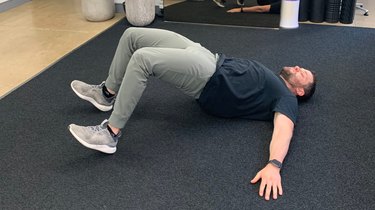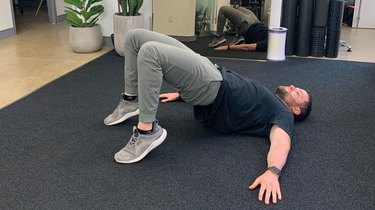
Your shin bone's connected to your hip bone — and to relieve or reduce the risk of shin splints, you need to work both.
First off, strengthening the muscles on both sides of your shin bone (aka tibialis) is a critical part to any good exercise for shin splits, says Sam Becourtney, PT, DPT, CSCS, a New York-based physical therapist with Bespoke Treatments.
Video of the Day
Video of the Day
After all, also called medial tibial stress syndrome, shin splits happen when your shin bone and connective tissues take on too much stress. And your shin muscles, including your tibialis anterior in the front of your leg and the calf muscles in the back, work like scaffolding. They protect and take excess pressure off of the shin bone when running.
But to ease shin splits, your lower-body strengthening shouldn't stop there. You also need to build your glutes. When these large hip muscles are strong, they're better able to carry some of the weight that would otherwise go to your shins. They also help stabilize your body for healthy pain-free running form.
Fortunately, these two glute bridges for shin splints do both — strengthening your lower legs and glutes at the same time. If you're prone to shin pain, make these moves a regular part of your warm-up, cross-training or strength-training sessions.
Move 1: Glute Bridge With Toes Raised

- Lie on your back with your arms at your sides, knees bent and toes pointing up in the air (heels pressing into the ground).
- On an exhale, squeeze your glutes, press into your heels and drive your hips up toward the sky.
- Raise your hips until you form a diagonal line from knees to hips to chest.
- Pause here for a moment.
- Reverse the motion and return to the starting position, keeping your toes raised the entire time.
Tip
This glute bridge for runners keeps your tibialis anterior in the front of your shin contracted at all times, Becourtney says. To get the most out of this move, actively flex your foot as far as you can while maintaining good form.
Move 2: Glute Bridge With Heels Raised

- Lie on your back with your arms at your sides, knees bent and heels lifted so that you're balancing on the balls of your feet.
- On an exhale, squeeze your glutes, press into the balls of your feet and drive your hips up toward the sky.
- Raise your hips until you form a diagonal line from knees to hips to chest.
- Pause here for a moment.
- Reverse the motion and return to the starting position, keeping your toes pointed the entire time.
Tip
The other side of the shin splint equation is strengthening your calves while stretching your shins. An easy way to do that is to raise your heels instead of your toes during glute bridges, Becourtney says.
Again, really try to own the movement. Keep your heels lifted as high as comfortable (aka without cramping).
Warning
Doing these two exercises isn't a cure-all for reducing the risk of shin splints.
In addition to strengthening and stretching your lower body, you still need to wear the best running shoes for your foot type, do dynamic warm-ups and increase you mileage no more than 10 percent each week.
Was this article helpful?
150 Characters Max
0/150
Thank you for sharing!
Thank you for your feedback!